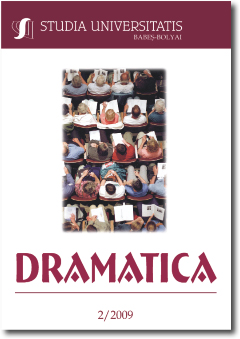ADAPTING SHAKESPEARE’S ADAPTATIONS IMAGE, CONTENT AND NARRATIVE PROBLEMS (AND SOLUTIONS) IN SHAKESPEARE’S ADAPTATIONS,A STUDY CASE ON ROMEO AND JULIET
ADAPTING SHAKESPEARE’S ADAPTATIONS IMAGE, CONTENT AND NARRATIVE PROBLEMS (AND SOLUTIONS) IN SHAKESPEARE’S ADAPTATIONS,A STUDY CASE ON ROMEO AND JULIET
Author(s): Doru PopSubject(s): Theatre, Dance, Performing Arts
Published by: Studia Universitatis Babes-Bolyai
Keywords: Shakespeare; movies; adaptations.
Summary/Abstract: Shakespeare is one of the most “adapted” classical authors, and the desire for adapting Shakespearean plays and plots seems to increase over time. From George Cukor, Franco Zefirelli and Akira Kurosawa, to directors/writers like Baz Luhrmann and actors/directors like Lawrence Olivier or Kenneth Branagh, the temptation to adapt „Old Will” to new contexts has remained intact. Over the years more than 250 movies were made on Shakespearean sources. These movies were inspired, developed from, adaptated from, transformed from or trancoded from the plays and ideas of the XVIth Century author. No production limits were given to the Bard, Hollywood expensive productions, BBC faithfull series, independent cinematographers, Japanese and Thai filmakers, Bollywood productions, a range of various genres from basic filmed stage representations, to complex television productions or film adaptations or animations and manga productions reinterpreted in diverse cultural and political contexts throughout the world the works of the most important drama writer of all times. In the past 200 years Shakespeare’s works were reworked in different mediums; they were transposed into poems, paintings, operas, and other melodramatic context, and now with the on-screen transcoding of his works the public has them more easily, the Shakespearean text being available to large publics and to new and challenging artistic contexts. A couple of questions come out of this: is the popularizing of the Great Will affecting the content of his plays? What is “truly” Shakespearean and what is jus “like” Shakespeare or inspired by the Bard in these new versions? Some critics, like James Agee and Normand Berlin, have used methods of evaluating these problems according to degrees of fidelity and/or distortion of the text. How many lines were included, how faithful was the movie production to the original source in terms of textual fidelity is one way to see the adaptation process. Another would be to consider the fundamental question of fidelity in the general context of adapting Shakespeare’s works into movies.
Journal: Studia Universitatis Babes-Bolyai - Dramatica
- Issue Year: 2009
- Issue No: 2
- Page Range: 43-53
- Page Count: 11
- Language: English

